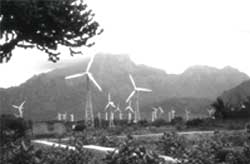Free for all
 To attract private investment in the wind energy sector in 1993, the government announced a package of fiscal incentives. This included 100 per cent accelerated depreciation on the capital investment in the first year of operation; 35 per cent concessional duty on import of complete wind electricity generator; duty exemption on import of 10 specified wind energy generator ( weg ) components; five-year tax holiday; customs and excise exemptions; and liberalised foreign investment procedures.
To attract private investment in the wind energy sector in 1993, the government announced a package of fiscal incentives. This included 100 per cent accelerated depreciation on the capital investment in the first year of operation; 35 per cent concessional duty on import of complete wind electricity generator; duty exemption on import of 10 specified wind energy generator ( weg ) components; five-year tax holiday; customs and excise exemptions; and liberalised foreign investment procedures.
The most notable of the incentives offered was the 100 per cent tax depreciation. This means that if a company's taxable income (outside the wind power project) for the financial year is, for instance, Rs 10,000, the company can show investments on WEG to the tune of Rs 10,000 and get away by paying no tax at all. The government, in all earnest, may have started this scheme to attract investors. Attract investors, they did. But 70 per cent of them were only interested in benefiting from the tax waivers.
The present value of tax loss to the government through 100 per cent depreciation allowance works out to Rs 37 lakh per 250 kilowatt (mw) machine, according to the study report on the "Economics of Wind Power' by the Tata Energy Research Institute (TERI). If the 33.3 per cent depreciation allowance applicable to other conventional power investments is taken into consideration, the present value of tax loss would be to the tune of Rs 29.8 lakh per kw machine. Therefore, the implied incremental subsidy is Rs 7.5 lakh per kw machine (Rs 37.2-Rs 29.8) or around Rs 30 lakh per megawatt (mw).
Accordingly, for the 900 mw installed capacity up to March 1997, the effective subsidy to the wind energy programme, through accelerated depreciation benefit is estimated to be of the order of Rs 270 crore.
The accelerated depreciation scheme has been the main incentive in Tamil Nadu, Andhra Pradesh and Gujarat in expanding the installed capacity of wind power. The rapid expansion the wind power capacity between 1993-97 can be traced to this incentive. But all investment-based incentives suffer from the same constraints. And this one was no different. "Investment decisions were taken purely with the objective of avoiding the current tax liability rather than on a detailed long-term analysis of the projected returns from the venture, often negatively affecting generation,' states the TERI report. "Where capital investment subsidies are misused, they provide a distorted picture of the actual subsidisation of power produced since the generation remains low despite higher public expenditure on subsidies.'
Related Content
- Order of the National Green Tribunal regarding construction at Mahanadi river bank near Baliyatra ground of Cuttack city, Odisha, 24/04/2024
- Draft guidelines for implementation of PM-Surya Ghar: Muft Bijli Yojana in residential sector
- The global atlas for renewable energy: a decade in the making
- Economic valuation of ecosystem services of selected interventions in agriculture in India
- Order of the National Green Tribunal regarding illegal sand mining in Brahmani river at Gopinathpur, Angul district, Odisha, 12/03/2024
- Order of the National Green Tribunal regarding pollution of storm water drain, Damoh, Madhya Pradesh, 06/3/2024
